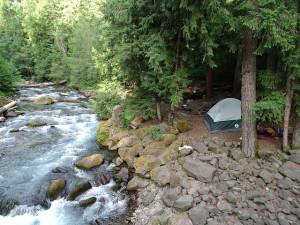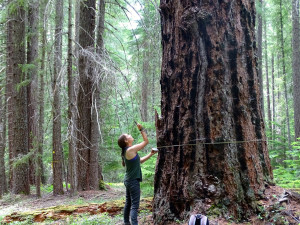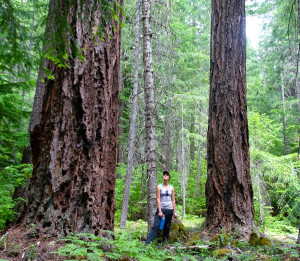by Jaclyn Hise and Amanda Martino, Cascadia Wildlands summer legal interns
Our first overnight field excursion as summer interns was visiting the Loafer timber sale in the Umpqua National Forest in the southern Oregon Cascades near the Umpqua Hot Springs. The units to be logged span both sides of the North Umpqua River, whose picturesque winding curves, clear blue water, and rushing rapids guarantee breathtaking views from any stop. The Loafer sale units will have logging of varying degrees, such as thinning or gap creation. One of the biggest concerns we have regarding the Loafer sale are the 5.6 miles of new temporary roads and 3 miles of reconstructed temporary roads to be built, as well as an additional 31 miles of road maintenance proposed for the haul operations that will accompany the sale.
Our first overnight field excursion as summer interns was visiting the Loafer timber sale in the Umpqua National Forest in the southern Oregon Cascades near the Umpqua Hot Springs. The units to be logged span both sides of the North Umpqua River, whose picturesque winding curves, clear blue water, and rushing rapids guarantee breathtaking views from any stop. The Loafer sale units will have logging of varying degrees, such as thinning or gap creation. One of the biggest concerns we have regarding the Loafer sale are the 5.6 miles of new temporary roads and 3 miles of reconstructed temporary roads to be built, as well as an additional 31 miles of road maintenance proposed for the haul operations that will accompany the sale.
As they usually are during the hot days of summer, the Umpqua Hot Springs and adjacent campsites were bustling with hikers, cyclists, families, and their four-legged friends. After seeing how busy the campsites along the Umpqua River were, we found a spot along the nearby road with a coveted picnic table and fire pit and set up camp. Tucked along the edge of the forest and set back from the road, sunlight streamed through the clearing and we remarked at our luck at finding the spot. Only after consulting the map did we find that this beautiful camping site was marked to become a future helicopter land spot. Three more camping sites along the road would also be sacrificed to landing helicopters used during the logging process.
clearing and we remarked at our luck at finding the spot. Only after consulting the map did we find that this beautiful camping site was marked to become a future helicopter land spot. Three more camping sites along the road would also be sacrificed to landing helicopters used during the logging process.
 clearing and we remarked at our luck at finding the spot. Only after consulting the map did we find that this beautiful camping site was marked to become a future helicopter land spot. Three more camping sites along the road would also be sacrificed to landing helicopters used during the logging process.
clearing and we remarked at our luck at finding the spot. Only after consulting the map did we find that this beautiful camping site was marked to become a future helicopter land spot. Three more camping sites along the road would also be sacrificed to landing helicopters used during the logging process.We set off to walk through the first set of units that will be thinned from their thick and natural growth. We hiked off the road and followed Forest Service tape marking where new roads would traverse the units and allow truck access. We received a crash course in tree identification from our Conservation Director Francis Eatherington as we walked through sugar, white, ponderosa, and lodge pole pines, hemlocks, cedars, white fir and Douglas fir trees in our search for old-growth trees. Not to be disappointed, we soon stumbled upon these gentle giants. Estimated to be at least 600 years old and with diameters between 6 and 7 feet, these magnificent trees had a humbling effect on our group as we stood beside them. Some of these old-growth trees bear the blackened scars of past fires, true visual testaments to all they have survived, and the times they have stood strong throughout. We marveled at the tumult and storms they had weathered and the services they had provided the forest in their lifetimes. These old-growth trees are crucial desired habitat for the northern spotted owl, a threatened species that faces increasing pressures from deforestation and increased competition from the more aggressive barred owl. Although the old growth themselves would not be logged, the surrounding forest will be in this sale. Protecting old growth trees such as these and the areas surrounding old growth will be paramount in protecting the spotted owl from further losses and ensuring its survival. To think we could one day lose both an iconic species and these towering forest pillars was a sobering thought.
 After a long day of hiking through the forest, we walked up to the hot springs to relax and enjoy its picturesque views. The hot springs are on the side of a ridge and look out over the North Umpqua River – and several of the units that will be logged in the Loafer sale. The view of the winding blue river and thick surrounding forest in the late afternoon sun was magnificent, and there were plenty of visitors to take in the sights. We wondered if they knew what the view would look like after the logging was done – the once full and lush forest riddled with roads and whole areas thinned.
After a long day of hiking through the forest, we walked up to the hot springs to relax and enjoy its picturesque views. The hot springs are on the side of a ridge and look out over the North Umpqua River – and several of the units that will be logged in the Loafer sale. The view of the winding blue river and thick surrounding forest in the late afternoon sun was magnificent, and there were plenty of visitors to take in the sights. We wondered if they knew what the view would look like after the logging was done – the once full and lush forest riddled with roads and whole areas thinned.The next day we hiked along the side of the Umpqua River, along the North Umpqua Trail. The mountain wall rose up directly next to us and beautiful waterfalls of natural spring water flowed down its side into the Umpqua. Several waterfalls had chiseled out unique rock formations and walls of moss dripped spring water into flowing streams at our feet. One of the units to be logged lay directly above our heads and these stunning hydrological features. Any logging above would surely be felt below – the sounds of machinery and trucks, the dust, dirt, and pollution, and the gaps in the tree coverage above. Pollution and debris from the logging would be carried down via these springs and waterfalls into the Umpqua and the numerous campsites between it and the trail. All those who visit this area, cyclists, backpackers, hikers, campers, would notice a change to the peace, beauty, and natural setting of the trail and riparian area.
We surveyed several other units that would be thinned for meadow restoration and winter elk habitat. By the abundance of elk tracks and other indicators throughout all of the units, it didn’t seem like there was any shortage of habitat for them. We wound our way through several sunlit meadows full of ferns taller than ourselves and around brush, bushes, and wild strawberries. Frogs jumped from puddles of water into nearby vegetation.
Tired from our two-day trek up and down hillsides, we headed to soak our feet in the Umpqua and to reflect over all we had seen. It’s one thing to read about the proposed road construction and maintenance and logging plans, and another to touch the sides of trees that will be cut for roads, to stand in the shadows of 600 years of growth and resilience that will be surrounded by cutting, to drink water from a natural cascading spring, and to wake up in a sunlit campsite. The proposed Loafer timber sale will forever alter the natural beauty of the Umpqua National Forest, the Umpqua Hot Springs, and the North Umpqua Trail. We returned home with more determination to preserve this amazing forest for all who wish to visit the area and have these experiences. Cascadia Wildlands is currently commenting on the Forest Service’s new Environmental Assessment and making formal administrative objections to the Loafer timber sale.
to read about the proposed road construction and maintenance and logging plans, and another to touch the sides of trees that will be cut for roads, to stand in the shadows of 600 years of growth and resilience that will be surrounded by cutting, to drink water from a natural cascading spring, and to wake up in a sunlit campsite. The proposed Loafer timber sale will forever alter the natural beauty of the Umpqua National Forest, the Umpqua Hot Springs, and the North Umpqua Trail. We returned home with more determination to preserve this amazing forest for all who wish to visit the area and have these experiences. Cascadia Wildlands is currently commenting on the Forest Service’s new Environmental Assessment and making formal administrative objections to the Loafer timber sale.
 to read about the proposed road construction and maintenance and logging plans, and another to touch the sides of trees that will be cut for roads, to stand in the shadows of 600 years of growth and resilience that will be surrounded by cutting, to drink water from a natural cascading spring, and to wake up in a sunlit campsite. The proposed Loafer timber sale will forever alter the natural beauty of the Umpqua National Forest, the Umpqua Hot Springs, and the North Umpqua Trail. We returned home with more determination to preserve this amazing forest for all who wish to visit the area and have these experiences. Cascadia Wildlands is currently commenting on the Forest Service’s new Environmental Assessment and making formal administrative objections to the Loafer timber sale.
to read about the proposed road construction and maintenance and logging plans, and another to touch the sides of trees that will be cut for roads, to stand in the shadows of 600 years of growth and resilience that will be surrounded by cutting, to drink water from a natural cascading spring, and to wake up in a sunlit campsite. The proposed Loafer timber sale will forever alter the natural beauty of the Umpqua National Forest, the Umpqua Hot Springs, and the North Umpqua Trail. We returned home with more determination to preserve this amazing forest for all who wish to visit the area and have these experiences. Cascadia Wildlands is currently commenting on the Forest Service’s new Environmental Assessment and making formal administrative objections to the Loafer timber sale.(Photos by Francis Eatherington from top to bottom: Campsite along the North Umpqua River during a recent fieldcheck of the Loafer timber sale; Unit 29 of the Loafer timber sale, old-growth trees marked for retention; Field checking unit 26 of the Loafer timber sale, old-growth trees marked for retention)
